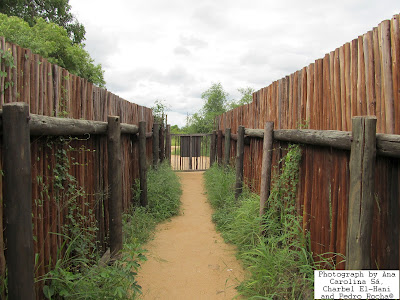Gardenia hide, um abrigo para visualização de pássaros na James Road (S119), foi uma bela parada para descansar, diante de uma vista agradável, em frente a um reservatório d’água. Infelizmente, o abrigo não tem banheiro, o que permitiria outro tipo de alívio, se bem nos entendem.
É excitante sair do carro em meio à savana africana, ainda que seja para cruzar o curto caminho até a entrada do abrigo. Na primeira foto, vemos Carol e Peu percorrendo a paliçada para entrar no abrigo. Na foto abaixo, o pequeno portão que separa a paliçada da savana. Pareceu bem apropriado andar rapidamente ao longo da paliçada! Por fim, a terceira foto mostra Charbel tirando fotografias de dentro do abrigo.
Passamos cerca de 25 minutos no abrigo, observando e fotografando os seguintes animais:
Impalas (Aepyceros melampus)
1 Ganso Egípcio (Alopochen aegyptiaca)
2 Abibes-preto-e-branco (Vanellus armatus)
1 Francolim-de-poupa (Peliperdix sephaena)
3 Tartarugas de Escudo Africanas (Pelomedusa subrufa)
2 Alcaravões-d'água (Burhinus vermiculatus)
1 Gecko Anão do Cabo (Lygodactylus capensis)
Se você estiver passando por esta região do sul do Kruger, recomendamos que pare nesse abrigo. O reservatório d’água é lamacento e lemos relatos de que, em épocas mais secas, ele pode ficar sem água. Na estação seca, contudo, se ele estiver com água, você pode ter a sorte de ver búfalos e elefantes que vêm regularmente beber água nesse local. Nesta estação, aliás, ir atrás de reservatórios, estrategicamente colocados na beira das estradas de modo a maximizar as chances de os visitantes virem animais, é uma boa idéia. Pode-se até mesmo passar longos tempos em abrigos como o Gardenia esperando que animais venham beber água.
Como visitamos o Kruger no verão, na estação chuvosa, a savana estava cheia de poças de água e os animais não visitavam os reservatórios com a mesma freqüência para beber. Assim, deslocamo-nos ativamente durante todo o dia em busca de animais, com paradas relativamente curtas em abrigos como este. Também é divertido sair atrás dos animais percorrendo as estradas e, como não tivemos dificuldade em ver mais de 100 animais por dia durante os 14 dias que passamos no parque, pareceu-nos que vale a pena visitá-lo tanto na estação chuvosa, quanto na estação seca.
Devido ao fato de animais não virem beber água em reservatórios na época em que estávamos no parque, vimos em Gardenia Hide principalmente aves aquáticas.
Gardenia bird hide, in James Road (S119), was a nice stop to rest, in front of a waterhole. Unfortunately, the hide has no bathroom, what would allow another type of relief, if you understand us.
It is exciting to leave the car in the middle of the African savannah, even if only to cross the short way up to the entrance of the hide. In the first picture, we see Carol and Peu walking along the palisade in order to enter the hide. In the picture below, the small gate that separates the palisade from the savannah. It seemed just right to walk a bit fast down the palisade! Finally, the third picture shows Charbel taking photographs within the hide.
We spent around 25 minutes in the hide, observing and photographing the following animals:
Impalas (Aepyceros melampus)
1 Egyptian Goose (Alopochen aegyptiaca)
2 Blacksmith Lapwings (Plovers) (Vanellus armatus)
1 Crested Francolin (Peliperdix sephaena)
3 Marsh or Helmeted Terrapins (Pelomedusa subrufa)
2 Water Thick-Knees (Dikkops) (Burhinus vermiculatus)
1 Cape Dwarf Gecko (Lygodactylus capensis)
If you pass through this region of the Kruger, we recommend a stop at this hide. The waterhole is muddy and we read reports that it can have no water in the drier times. In the dry season, however, if it has water, you may be lucky enough to see buffalos and elephants that come regularly to drink at this spot. In this season, by the way, to look for waterholes, strategically put at the margin of the roads to maximize the chances that visitors see animals, is a good idea. One can even stay for long times in hides such as Gardenia waiting for the animals to come to drink.
As we visited the Kruger in the summer, in the rain season, the savannah was full of small pools and the animals did not visit the waterholes so often to drink. Thus, we actively moved during the whole day looking for animals, with relatively short stops in hides like this one. It is also fun to go after the animals following the roads and, as we did not experience difficulties in seeing more than 100 animals per day during the 14 days in the park, it seems to us that it is worth visiting it either in the rain or in the dry season.
Due to the fact that the animals do not come to drink water in waterholes during the time we were in the park, most of the animals we saw in Gardenia were aquatic birds



Nenhum comentário:
Postar um comentário